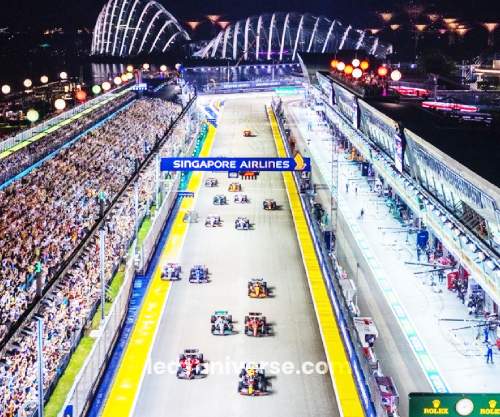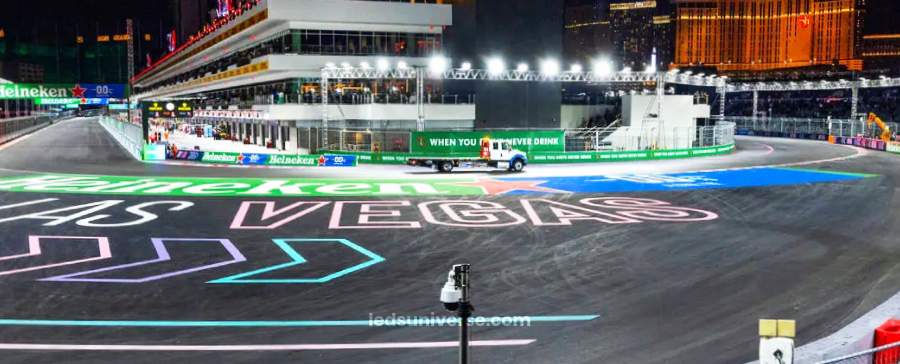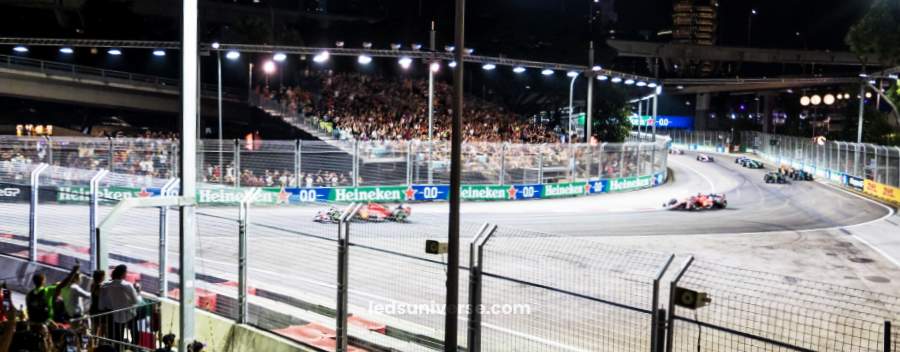Race tracks come alive after dark, where the roar of engines and the thrill of competition demand impeccable lighting. Modern LED systems transform these venues, providing not only crucial visibility but also enhancing every moment of the race with vibrant, precise illumination. As the night envelops the track, advanced lighting ensures that every turn, straightaway, and finish line gleams with excitement and safety.
Whether it’s for car racing, horse racing, or motorcycle events, a well-lit track allows drivers, riders, and spectators to enjoy a seamless experience, even during nighttime or adverse weather conditions. Today, LED lighting is becoming the go-to solution, providing significant advantages over traditional lighting systems.
Reach out for free lighting consultation
LED lights are rapidly replacing traditional lighting systems in many race tracks. The energy efficiency and low maintenance costs make LED lighting an ideal choice for large-scale installations. Earlier versions of LED lighting were often criticized for their blue-colored hues. However, advancements in LED technology have made it possible to produce white light, enhancing visibility on the track. With these improvements, LED race track lighting has become more accessible to the market, with many manufacturers now offering various LED lighting solutions tailored to the specific needs of race tracks.
Race tracks prefer LED lighting systems due to their longevity and low electricity consumption. These lights can operate for more than 100,000 hours and require much less energy than older systems like metal halides and high-intensity discharge (HID) lamps. From LED race track lighting fixtures to LED race arena lights, the versatility of these systems offers flexibility in installation and lighting design.
Table of Contents
Toggle Race tracks utilize different types of lighting systems based on the layout and requirements of the event. Each type plays a vital role in ensuring the track is well-lit, providing the necessary visibility for drivers, riders, and spectators.
Race tracks utilize different types of lighting systems based on the layout and requirements of the event. Each type plays a vital role in ensuring the track is well-lit, providing the necessary visibility for drivers, riders, and spectators.
Floodlights are widely used in race tracks to provide broad illumination. These lights are typically mounted on tall poles or towers, ensuring that large areas of the track are covered. Floodlights are ideal for straight sections of the track where even lighting is essential for driver visibility and safety.
Spotlighting focuses intense beams of light on specific areas, such as sharp turns, corners, or the finish line. These lights help highlight critical points on the track where precision is key, allowing drivers to anticipate and react to sudden changes in the course. Spotlights also serve to illuminate pit areas and spectator stands, enhancing safety and visibility in these regions.
LED lights have become a popular choice for race tracks due to their energy efficiency, longevity, and customizable features. Unlike traditional lighting systems, LEDs allow for more control over brightness and color temperature, ensuring a well-balanced lighting environment. LED race track lighting systems can be programmed for dynamic lighting effects, adding an element of excitement to races.
Portable lighting systems are a great option for temporary or flexible lighting needs. These lights are particularly useful for events that require quick setup or for tracks that may not have a permanent lighting infrastructure. Portable LED lights provide sufficient brightness, are easy to install, and can be moved around as needed to accommodate different track layouts or racing events.

Lighting for car racing must be exceptionally bright to ensure both safety and optimal performance. The level of brightness is measured in lux, which indicates how much light falls on a given area. For car racing, maintaining high lux levels is crucial due to the high speeds and the need for precise visibility.
Car racing tracks require a significant amount of illumination to meet safety and performance standards. Typically, lux levels for these tracks range from 300 to 800 lux. The specific requirement within this range depends on several factors, including the track’s size and the speed of the vehicles. Larger tracks and faster speeds necessitate higher lux levels to ensure that every part of the track is adequately illuminated. This brightness helps drivers navigate turns, detect obstacles, and react quickly, reducing the risk of accidents and improving overall safety.
High lux levels on car racing tracks enhance visibility for both drivers and spectators. For drivers, sufficient lighting is critical for making split-second decisions and maintaining control of their vehicles at high speeds. It ensures that the track’s surface, markings, and barriers are clearly visible, allowing for precise maneuvering and reducing the likelihood of collisions.
For spectators, bright and uniform lighting improves the viewing experience, making it easier to follow the action from the stands. It also ensures that all aspects of the event, from the start line to the finish, are clearly visible, adding to the excitement and enjoyment of the race.
Modern LED lighting systems are particularly effective for car racing tracks due to their ability to provide intense, consistent illumination while minimizing glare. LED lights can be precisely directed to avoid unnecessary light spill and focus illumination where it’s most needed. This glare reduction technology helps prevent visual impairment for drivers, maintaining a clear view of the track and improving overall safety.
Moreover, LED lighting systems adhere to international sports lighting standards, ensuring that they deliver the necessary brightness while balancing visual comfort. These systems are designed to be energy-efficient and long-lasting, providing a reliable solution for race tracks that need high levels of illumination without frequent maintenance.

Race tracks are complex environments with straightaways, sharp corners, and variable elevations, all of which require careful consideration when positioning lights.
Floodlights are typically placed along the straightaways to ensure even coverage, while spotlights are positioned at critical points such as sharp curves, starting lines, and the finish line. The goal is to avoid shadows or dark spots on the track, which could create hazards for drivers or riders. Lights must also be positioned to provide sufficient illumination in the pit areas, ensuring the safety of crews and enhancing visibility for technical work.
In addition to illuminating the track, proper lighting is necessary for spectator stands, parking areas, and entry points. Lighting in these areas ensures that fans and participants can safely navigate the facility before, during, and after the event.
Race tracks are frequently situated near residential areas, which necessitates careful management of light pollution to avoid disturbing nearby communities. Effective light pollution control is crucial for maintaining good relationships with local residents and ensuring compliance with environmental regulations.
LED lighting provides an effective solution for minimizing light pollution through its directional lighting capabilities. Unlike traditional lighting systems that often scatter light in all directions, LED fixtures can be designed to direct light precisely where it is needed. This focused illumination reduces unwanted light spill into adjacent areas, making it easier to keep lighting contained within the race track boundaries.
To further mitigate light pollution, LED lighting systems can be equipped with shielding and adjustable fixtures. These features allow for precise control over the direction and distribution of light. By focusing the light directly on the track and its immediate surroundings, these systems prevent excessive illumination from reaching residential areas or other sensitive locations. This targeted approach not only improves the quality of light for the race but also minimizes the impact on nearby communities.
In addition to controlling light spill, advanced LED systems are designed to address glare reduction. Glare can be a significant issue, particularly during night races, where excessive brightness or poorly positioned lights can impair drivers’ vision and increase the risk of accidents.
LED lighting fixtures incorporate glare reduction technology to ensure that the track is brightly illuminated without compromising visibility. This technology includes features such as diffusers and optical controls that help distribute light evenly and reduce harsh glare. By minimizing glare, LED lighting systems enhance safety for drivers, riders, and spectators, ensuring a clear and unobstructed view of the track.
Effective glare reduction is particularly important for maintaining the safety and performance of night races. Properly designed LED lighting systems not only illuminate the track effectively but also create a visually comfortable environment that supports optimal racing conditions. This balance between brightness and glare control ensures that all participants can perform at their best without the distraction or danger of excessive glare.
Race tracks, by their nature, are exposed to a variety of weather conditions that can challenge the durability of lighting systems. These outdoor venues must endure rain, wind, dust, and other environmental factors that can impact the performance and lifespan of lighting equipment.
To address these challenges, LED lighting fixtures are specifically designed with advanced weather-resistant features. Modern LED lighting systems are engineered to be waterproof, meaning they are sealed against moisture ingress. This ensures that even in heavy rain or wet conditions, the lighting remains fully operational without any risk of electrical failures. Corrosion resistance is another critical aspect, as it protects the fixtures from the long-term effects of humidity and exposure to rain, preventing rust and deterioration.
In addition to waterproofing and corrosion resistance, these lighting systems are built to withstand strong winds and vibrations. Race tracks often experience high-speed winds and the physical vibrations caused by fast-moving vehicles. LED fixtures are designed with robust construction to endure these stresses, maintaining their stability and functionality during intense racing events. This durability ensures that the lighting continues to perform reliably under demanding conditions, contributing to the overall safety and effectiveness of the track.
Safety and security are paramount considerations for race tracks, and lighting plays a crucial role in addressing these needs. Beyond providing illumination for the race itself, lighting systems must also support emergency protocols and enhance security measures.
LED lighting systems can be integrated with emergency lighting features, ensuring that the track remains well-lit in the event of an accident or an evacuation. This integration allows for rapid response and safe evacuation procedures, maintaining clear visibility even in critical situations. Emergency lighting helps guide drivers, riders, and spectators to safety, minimizing the risk of accidents and injuries.
In addition to emergency lighting, LED systems often work in conjunction with security cameras. Properly illuminated tracks and surrounding areas provide clear visibility for surveillance, aiding in the monitoring and security of the venue. This enhanced visibility supports the detection of any suspicious activities or incidents, ensuring a safer environment for all attendees.
The longevity and low maintenance requirements of LED lights make them an attractive choice for race tracks. One of the key advantages of LED lighting is its extended lifespan. LED fixtures can last up to 100,000 hours, which significantly reduces the need for frequent replacements compared to traditional lighting technologies.
This extended lifespan not only lowers maintenance costs but also minimizes disruptions during racing events. Fewer replacements mean less downtime and fewer interruptions, ensuring that the track remains fully illuminated and operational.
Regular inspections are still essential to ensure that all lights are functioning optimally. Modern LED systems often come equipped with remote monitoring capabilities, which allow operators to receive real-time alerts about any potential issues. This proactive approach enables timely maintenance and repairs, addressing problems before they impact the performance of the lighting system.
LED lighting has revolutionized race track illumination, offering numerous advantages over traditional lighting systems. From energy efficiency and durability to safety and enhanced visibility, modern lighting solutions ensure that race tracks can provide a superior experience for participants and spectators alike. By considering the right types of lighting, lux requirements, and strategic placement, race tracks can optimize their lighting systems for performance, safety, and sustainability.